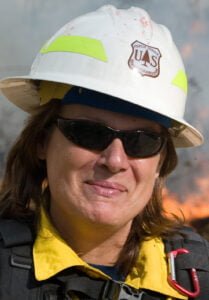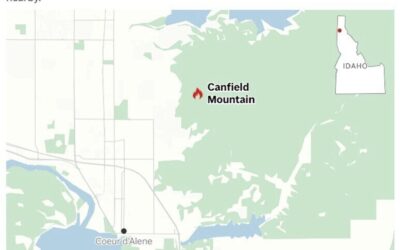Back in the 1970s, I had graduated with a degree in Natural Resource Management and had four fire seasons with the US Forest Service under my belt. I was now working as a range conservationist for a state agency and fighting fires as a part of their militia. One day, my boss came up to me and said, “You’ve got all that experience fighting fire, can you do a controlled burn on one of our rancher’s permits? Never being one to say no, I said, “Sure, I guess, I think so.”
Why not? I had four whole fire seasons. I had no idea what I didn’t know. And what I didn’t know was a lot. What could possibly go wrong? This was 1978 and we had no prescribed fire qualifications. Heck we didn’t even call it prescribed fire back then. We called it controlled burning. And with any luck my first burn would be a controlled one.
The rancher wanted me to burn about 300 acres of brush to improve forage production and increase water yield in his springs. These were good goals. They made sense to me. But I didn’t have access to a fire crew to cut lines, do prep work, help light and hold. No, this would be a seat of the pants kind of burn.
I reduced the size of the burns to several small (20 acre) plots just to make sure I wasn’t lighting too much at one time and to give me some confidence that I could really do this. I had some sense at 23 years of age. But I still had no crew to put in my lines and help with the burn. So, I recruited the other “range cons” in the office to help. Of course they had no fire experience at all. This would be like the blind leading the blind.
The day I chose to burn was in late spring after the annual grasses had dried out but before conditions became too extreme. The most important issue for me was when I could get everyone in the office to help. That was my prescription. When we all arrived at the burn site, I explained to my “crew” that we would use a two-track ridge top trail as our upper fireline. A sand wash down below would be our bottom line.
I lined out the crew, each with a back-pack pump and explained that I’d be lighting the fuel as we walked down from the ridge top trail to the sand wash down below. I explained that they were to use their water to keep the fire from spreading back towards us and allow it to burn back into the burn area. After igniting the two flanks and the top, I ran back down and burned out from the sand wash. Within a couple hours, my first 20 acre burn unit was completed. We finished the second unit before it got too hot that afternoon.
The next year, the Game and Fish Department along with the University Extension Service and Soil Conservation Service wanted to conduct a field trip and visit my burns. They didn’t have a lot of confidence in what I had been doing. Skepticism was the predominant feeling that day before we arrived. My bosses accompanied me down to the ranch. When we arrived, what we saw was an abundance of perennial grasses coming up and shrub species re-sprouting. Of course that’s what was happening. It makes sense to us now. But it wasn’t common sense to everyone back then.
We were successful. Of course, I just assumed we would be. But my confidence wasn’t based on years of experience, training or knowledge. It was just based on youthful enthusiasm with a minimum of actual understanding. I went on to continue burning in similar fuel types. As a matter of fact, I started getting calls from other agencies wanting to get copies of my prescriptions. I was perplexed. Prescriptions? What prescriptions? I was learning as I went and slowly learned to keep track of those parameters.
All my early burns weren’t quite as successful as that first one. One time, I wanted to re-seed some rangeland that had been overgrazed. There were some old juniper skeletons that were keeping us from running a rangeland drill through the pasture. Brush and old dead junipers were our fuel and under the right circumstance, it would burn hot and clean. This particular unit bordered a National Forest and was only a mile or two from a famous National Park.
Wanting to ensure our success, I invited the local USFS Fire Management Officer to bring his resources out and help us burn. I mean after all, the burn unit bordered his jurisdiction, so wouldn’t he want to participate?
“Nope. No. Not at all” he told me. He went on to tell me that In this fuel type we would be unlikely to meet our objectives of clearing the fuel enough to use a rangeland drill and re-seed the landscape. I said, “well, we’re going to give it a try anyway.” His answer to me was, “if you do get the fire to carry through the unit, you’ll never be able to hold on to it. You’ll lose it.” I looked at him like he had a horn sticking out of his forehead. “What? Come on. You can’t have to both ways. On one hand you say the fire won’t carry. But if it does, I’m going to lose it.” In my youthful enthusiasm, I thought he was just being a negative old coot. I thought he just didn’t want us to burn. Of course, I was wrong. Very wrong.
On the day of the burn, he came out with his district dozer. Interestingly enough we couldn’t get the fire to carry through the unit. We’d light but it wouldn’t carry from bush to bush. When we realized we would not get a good clean burn, we decided to just walk through the unit and light all the juniper skeletons. At least we’d make it easier to re-seed the land. I know you can see what’s coming now. With a little more experience, it makes perfect sense. But back then I didn’t have the experience I would gain with time. Now it was hot and dry in the afternoon and we had lots of fire spread across the unit. The fire took off. It was a 50 foot flaming front as it crossed the jurisdictional boundary and started burning the National Forest headed towards the National Park.
But the Forest Service was ready with their dozer and had a line around our slop over pretty quickly. Our 320 acre burn unit over accomplished about 100 acres onto the Forest. When we were done and resting on our truck tailgates, wiping the sweat from our foreheads and drinking water, the Forest Service FMO drove up to us and looked out his window at us. He never said a word. He rolled down his window but he never said anything. He just looked at us and started to say something once or twice. Finally, while looking at us, he just shook his head and drove away. I felt like the idiot he knew me to be.
We ended up being able to seed the rangeland and improve the habitat, but the most important accomplishment that day was what I learned. I learned that all my successful controlled burns up to that day were based too much on luck. I learned to pay attention to the details of the prescriptions that I started using. I took classes once they were developed. I also learned to discern between the grouchy old guys who just didn’t want me to burn and the old guys who wanted to teach me. That’s a critical difference to know because I’ve had both. But all the classes and technology didn’t change my innate feel for burning. There’s a lot of intuition that still needs to be a part of the equation. It’s not just about checking boxes on your burn plan. Check the boxes, but make sure you know what a good burn day feels like.
When I look back on how I started conducting controlled burns in the 1970s compared to my burning in the 2000s, I’m amazed at how successful I was and thankful for my good luck. I wish all you current burners good luck.
You can listen to this story in it’s entirety at http://bobbieonfire.com/2020/05/08/40-burning-by-the-seat-of-my-pants-my-first-controlled-burn/
Coming Soon
Both Sides of the Fire Line is Bobbie Scopa’s uplifting memoir of bravely facing the heat of fierce challenges, professionally and personally. It’s due out in September and available for preorder now.
Order from Amazon Order from Barnes & Noble

 Bobbie Scopa started her career as a seasonal firefighter in 1974. After graduating from Arizona State University, she went on to work in fire and natural resource management. Eventually she left the wildand agencies to work full time for a structure fire department. She finished her Masters in Forestry at NC State then went back to the US Forest Service and BLM eventually becoming the Assistant Regional Fire Director in Region 6. Bobbie has spent many years working as a type 1 and 2 Operations Section Chief. You can listen to Bobbie tell audio stories from her long career at BobbieOnFire.com. She has also recently completed her memoir titled “Both Sides Of The Fire Line”. It will be available through Chicago Review Press late summer of 2022.
Bobbie Scopa started her career as a seasonal firefighter in 1974. After graduating from Arizona State University, she went on to work in fire and natural resource management. Eventually she left the wildand agencies to work full time for a structure fire department. She finished her Masters in Forestry at NC State then went back to the US Forest Service and BLM eventually becoming the Assistant Regional Fire Director in Region 6. Bobbie has spent many years working as a type 1 and 2 Operations Section Chief. You can listen to Bobbie tell audio stories from her long career at BobbieOnFire.com. She has also recently completed her memoir titled “Both Sides Of The Fire Line”. It will be available through Chicago Review Press late summer of 2022.


